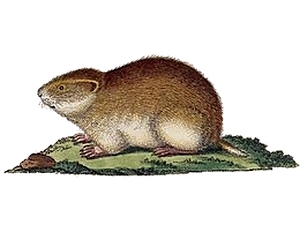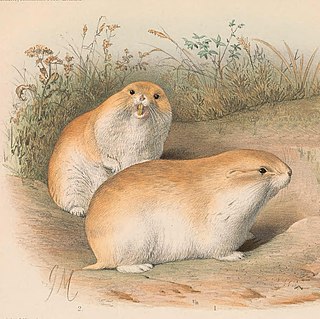
The Arvicolinae are a subfamily of rodents that includes the voles, lemmings, and muskrats. They are most closely related to the other subfamilies in the Cricetidae. Some authorities place the subfamily Arvicolinae in the family Muridae along with all other members of the superfamily Muroidea. Some refer to the subfamily as the Microtinae or rank the taxon as a full family, the Arvicolidae.

The northern collared lemming or Nearctic collared lemming, sometimes called the Peary Land collared lemming in Canada, is a small lemming found in Arctic North America and Wrangel Island. At one time, it was considered to be a subspecies of the Arctic lemming. Some sources believe several other species of collared lemmings found in North America are actually subspecies of D. groenlandicus.

The steppe lemming or steppe vole is a small, plump, light-grey rodent, similar in appearance to the Norway lemming, but not in the same genus. The steppe lemming eats shoots and leaves and is more active at night, though it is not strictly nocturnal. In the wild, it is found in steppes and semiarid environments in Russia, Ukraine, Kazakhstan, northwestern China, and western Mongolia. Fossil remains of this species have been found in areas as far west as Great Britain.

The genus Lemmus contains several species of lemming sometimes referred to as the true lemmings. They are distributed throughout the Holarctic, particularly in the Palearctic.

The Canadian lemming or Nearctic brown lemming is a small North American lemming.
The lemming vole is a species of rodent in the family Cricetidae. It is found only in the Russian Federation.
The Mongolian silver vole, also called the Mongolian mountain vole, is a species of rodent in the family Cricetidae. It is found mostly in Mongolia and small parts of southern Russia and northeastern China. In general, they are not crepuscular.

Dicrostonyx is a genus of rodent in the family Cricetidae. It contains the collared lemmings or varying lemmings. They are the only North American rodents that turn completely white in winter. It contains the following species:

The Arctic lemming is a species of rodent in the family Cricetidae.

The West Siberian lemming or Western Siberian brown lemming is a true lemming species found in the Russian Federation. Like other lemmings, it belongs to the family Cricetidae of rodents.

Przewalski's steppe lemming is a species of rodent in the family Cricetidae. It is found in China and Mongolia.

The West Siberian lemming or Western Siberian brown lemming is a true lemming species found in the Russian Federation. Like other lemmings, it belongs to the family Cricetidae of rodents.

The wood lemming is a species of rodent in the family Cricetidae. It belongs to the rodent subfamily Arvicolinae, so is a relative of the voles, lemmings, and muskrats. It is found in the taiga biome of China, Estonia, Finland, Mongolia, Norway, Russia, and Sweden.

A lemming is a small rodent, usually found in or near the Arctic in tundra biomes. Lemmings form the subfamily Arvicolinae together with voles and muskrats, which form part of the superfamily Muroidea, which also includes rats, mice, hamsters and gerbils. In popular culture, a longstanding myth holds that they exhibit herd mentality and jump off cliffs, committing mass suicide.

Lagurus is a genus in the subfamily Arvicolinae. Lagurus includes a single living species, the steppe lemming of central Eurasia. The North American sagebrush vole has also been included in Lagurus, but is likely not closely related. The earliest fossils of Lagurus, allocated to Lagurus arankae, appear in the Late Pliocene. Two other fossil species, Lagurus pannonicus and Lagurus transiens, are thought to be part of a lineage that led to the living steppe lemming.

The wildlife of Russia inhabits terrain that extends across 12 time zones and from the tundra region in the far north to the Caucasus Mountains and prairies in the south, including temperate forests which cover 70% of the country. Russia's forests comprise 22% of the forest in the world as well as 33% of all temperate forest.
E przewalskii may refer to:

Lagurini is a tribe of lemmings in the subfamily Arvicolinae. It contains three species in two genera. Species in this tribe are known as steppe lemmings.


















